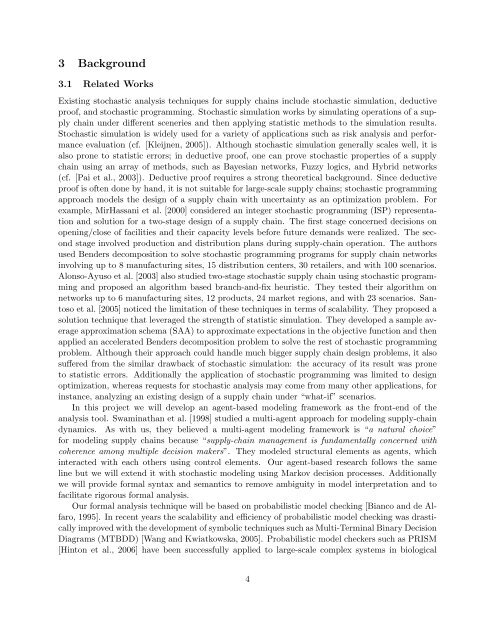SimRisk: An Integrated Open-Source Tool for Agent-Based ...
SimRisk: An Integrated Open-Source Tool for Agent-Based ...
SimRisk: An Integrated Open-Source Tool for Agent-Based ...
Create successful ePaper yourself
Turn your PDF publications into a flip-book with our unique Google optimized e-Paper software.
3 Background<br />
3.1 Related Works<br />
Existing stochastic analysis techniques <strong>for</strong> supply chains include stochastic simulation, deductive<br />
proof, and stochastic programming. Stochastic simulation works by simulating operations of a supply<br />
chain under different sceneries and then applying statistic methods to the simulation results.<br />
Stochastic simulation is widely used <strong>for</strong> a variety of applications such as risk analysis and per<strong>for</strong>mance<br />
evaluation (cf. [Kleijnen, 2005]). Although stochastic simulation generally scales well, it is<br />
also prone to statistic errors; in deductive proof, one can prove stochastic properties of a supply<br />
chain using an array of methods, such as Bayesian networks, Fuzzy logics, and Hybrid networks<br />
(cf. [Pai et al., 2003]). Deductive proof requires a strong theoretical background. Since deductive<br />
proof is often done by hand, it is not suitable <strong>for</strong> large-scale supply chains; stochastic programming<br />
approach models the design of a supply chain with uncertainty as an optimization problem. For<br />
example, MirHassani et al. [2000] considered an integer stochastic programming (ISP) representation<br />
and solution <strong>for</strong> a two-stage design of a supply chain. The first stage concerned decisions on<br />
opening/close of facilities and their capacity levels be<strong>for</strong>e future demands were realized. The second<br />
stage involved production and distribution plans during supply-chain operation. The authors<br />
used Benders decomposition to solve stochastic programming programs <strong>for</strong> supply chain networks<br />
involving up to 8 manufacturing sites, 15 distribution centers, 30 retailers, and with 100 scenarios.<br />
Alonso-Ayuso et al. [2003] also studied two-stage stochastic supply chain using stochastic programming<br />
and proposed an algorithm based branch-and-fix heuristic. They tested their algorithm on<br />
networks up to 6 manufacturing sites, 12 products, 24 market regions, and with 23 scenarios. Santoso<br />
et al. [2005] noticed the limitation of these techniques in terms of scalability. They proposed a<br />
solution technique that leveraged the strength of statistic simulation. They developed a sample average<br />
approximation schema (SAA) to approximate expectations in the objective function and then<br />
applied an accelerated Benders decomposition problem to solve the rest of stochastic programming<br />
problem. Although their approach could handle much bigger supply chain design problems, it also<br />
suffered from the similar drawback of stochastic simulation: the accuracy of its result was prone<br />
to statistic errors. Additionally the application of stochastic programming was limited to design<br />
optimization, whereas requests <strong>for</strong> stochastic analysis may come from many other applications, <strong>for</strong><br />
instance, analyzing an existing design of a supply chain under “what-if” scenarios.<br />
In this project we will develop an agent-based modeling framework as the front-end of the<br />
analysis tool. Swaminathan et al. [1998] studied a multi-agent approach <strong>for</strong> modeling supply-chain<br />
dynamics. As with us, they believed a multi-agent modeling framework is “a natural choice”<br />
<strong>for</strong> modeling supply chains because “supply-chain management is fundamentally concerned with<br />
coherence among multiple decision makers”. They modeled structural elements as agents, which<br />
interacted with each others using control elements. Our agent-based research follows the same<br />
line but we will extend it with stochastic modeling using Markov decision processes. Additionally<br />
we will provide <strong>for</strong>mal syntax and semantics to remove ambiguity in model interpretation and to<br />
facilitate rigorous <strong>for</strong>mal analysis.<br />
Our <strong>for</strong>mal analysis technique will be based on probabilistic model checking [Bianco and de Alfaro,<br />
1995]. In recent years the scalability and efficiency of probabilistic model checking was drastically<br />
improved with the development of symbolic techniques such as Multi-Terminal Binary Decision<br />
Diagrams (MTBDD) [Wang and Kwiatkowska, 2005]. Probabilistic model checkers such as PRISM<br />
[Hinton et al., 2006] have been successfully applied to large-scale complex systems in biological<br />
4




